The origin of projections from the posterior cingulate and retrosplenial cortices to the anterior, medial dorsal and laterodorsal thalamic nuclei of macaque monkeys
- PMID: 24134130
- PMCID: PMC4112842
- DOI: 10.1111/ejn.12389
The origin of projections from the posterior cingulate and retrosplenial cortices to the anterior, medial dorsal and laterodorsal thalamic nuclei of macaque monkeys
Abstract
Interactions between the posterior cingulate cortex (areas 23 and 31) and the retrosplenial cortex (areas 29 and 30) with the anterior, laterodorsal and dorsal medial thalamic nuclei are thought to support various aspects of cognition, including memory and spatial processing. To detail these interactions better, the present study used retrograde tracers to reveal the origins of the corticothalamic projections in two closely related monkey species (Macaca mulatta, Macaca fascicularis). The medial dorsal thalamic nucleus received only light cortical inputs, which predominantly arose from area 23. Efferents to the anterior medial thalamic nucleus also arose principally from area 23, but these projections proved more numerous than those to the medial dorsal nucleus and also involved additional inputs from areas 29 and 30. The anterior ventral and laterodorsal thalamic nuclei had similar sources of inputs from the posterior cingulate and retrosplenial cortices. For both nuclei, the densest projections arose from areas 29 and 30, with numbers of thalamic inputs often decreasing when going dorsal from area 23a to 23c and to area 31. In all cases, the corticothalamic projections almost always arose from the deepest cortical layer. The different profiles of inputs to the anterior medial and anterior ventral thalamic nuclei reinforce other anatomical and electrophysiological findings suggesting that these adjacent thalamic nuclei serve different, but complementary, functions supporting memory. While the lack of retrosplenial connections singled out the medial dorsal nucleus, the very similar connection patterns shown by the anterior ventral and laterodorsal nuclei point to common roles in cognition.
Keywords: cingulate cortex; memory; primate; retrosplenial cortex; thalamus.
© 2013 The Authors. European Journal of Neuroscience published by Federation of European Neuroscience Societies and John Wiley & Sons Ltd.
Figures
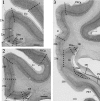

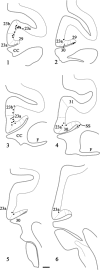

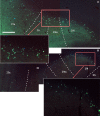
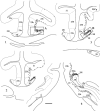

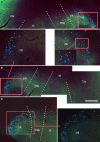
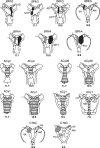
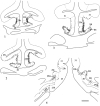

References
-
- Aggleton JP. Understanding anterograde amnesia: disconnections and hidden lesions. Q. J. Exp. Psychol. 2008;61:1441–1471. - PubMed
-
- Aggleton JP. Brown MW. Episodic memory, amnesia, and the hippocampal-anterior thalamic axis. Behav. Brain Sci. 1999;22:425–444. - PubMed
-
- Aggleton JP. Mishkin M. Projections of the amygdala to the thalamus in the cynomolgus monkey. J. Comp. Neurol. 1984;222:56–68. - PubMed
-
- Aggleton JP, Desimone R. Mishkin M. The origin, course, and termination of the hippocampo-thalamic projections in the macaque. J. Comp. Neurol. 1986;243:409–421. - PubMed
Publication types
MeSH terms
Grants and funding
LinkOut - more resources
Full Text Sources
Other Literature Sources

